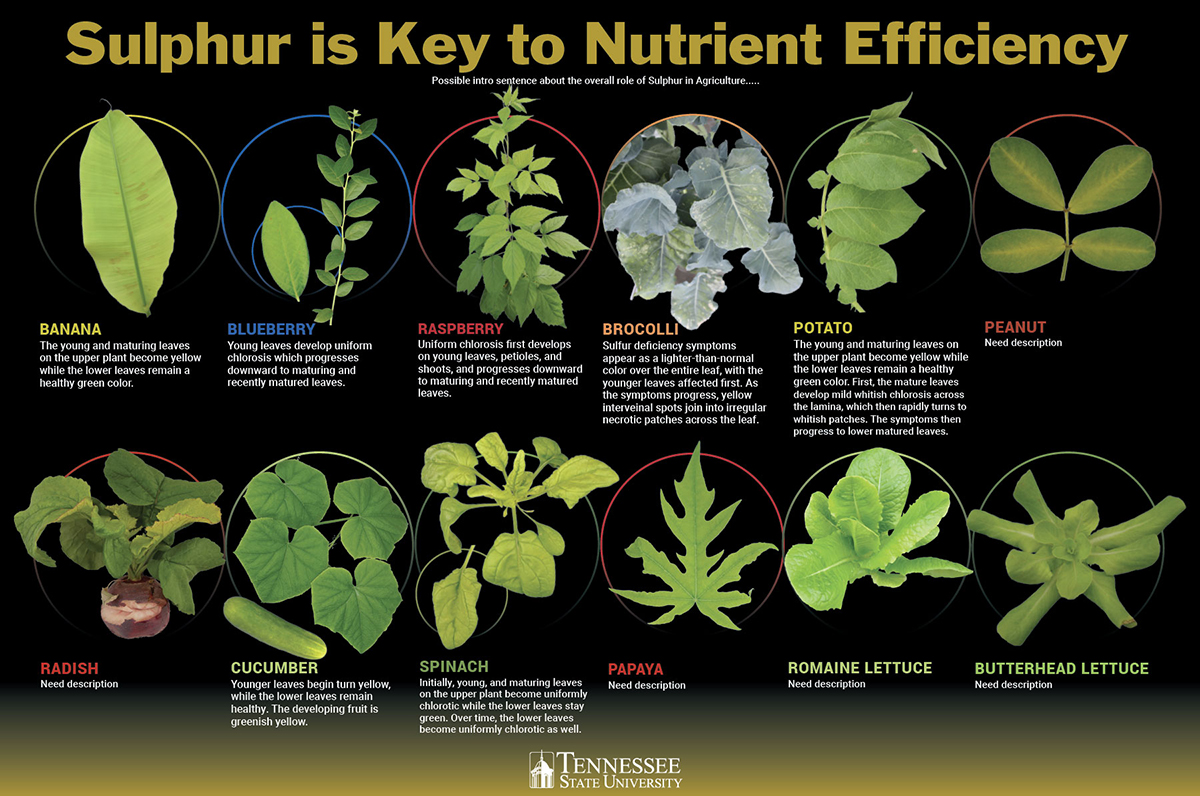Sulfur Deficiency Symptoms in Food Crops
S Deficiency Symptoms in Leading Staple Food Crops of the World
Barley: Sulfur deficiency can sometimes be confused with Nitrogen deficiency. Sulfur deficient plants have an overall yellow appearance similar to Nitrogen deficiency. However, Sulfur is not as mobile in the plant as Nitrogen, so the lower leaves do not show severer deficiency symptoms than the upper leaves. Click here for images of S deficiency in Cereal grains.
Maize: Yellowing between the veins along the entire length of the leaves is seen especially in younger, upper leaves. In later stages, reddening at the base of the stem and along the leaf margins may occur. Click here to view S deficiency symptoms in Maize.
Potato: There is pronounced inward curling of youngest leaves along with considerable yellowing of the stems. General yellowing of the plant is observed. Click here to see images of S deficiency symptoms in Potatoes.
Rapeseed Mustard: Cupped leaves and a reddening of the underside of leaves and stem is observed. Flowers abort prematurely resulting in poor pod formation. Sulphur deficiency reduces oil content in seeds and thus lowers the economic yield. Click here to see images of S deficiency symptoms in Rapeseed Mustard.
Rice: Initially the leaf sheath and then the leaf blade become yellowish. The whole plant may look chlorotic at tillering stage. Plant height and number of tillers are reduced. Panicles are fewer, shorter and bear fewer spikelets/grains than normal plants. Click here to see images of S deficiency symptoms in Rapeseed Rice.
Beans/Soybean: New leaves continue to remain pale-yellowish green. Size of leaves and length of internodes is reduced. Chlorosis starts from leaf margins and spreads inwards. Under severe deficiency, the entire plant may turn yellow leading to premature leaf fall, reduced flowering and fruiting. Click here to see images of S deficiency symptoms in Beans/Soybeans.
Sugarcane: Younger leaves develop a uniform yellowish-green color. Later, younger and older leaves show a faint purplish tinge. Stems are thinner and taper towards the tip. Click here to see images of S deficiency symptoms in Sugarcane.
Wheat: General yellowing of the plant is observed which is usually more prominent between the veins. Older leaves remain green. Barley will show similar symptoms. Click here to see images of S deficiency symptoms in Wheat.
S Deficiency Symptoms in Other Important World Crops
Banana: Young leaves show chlorosis (loss of green color resulting in pale yellow tissue) but as they age, the green color returns. Youngest uncurled leaves become yellowish-white as the deficiency progresses. If S-deficient conditions continue, chlorosis is clearer and pale stripes become visible between the veins. Growth is retarded and small fruits are produced.
Chickpea (Gram, Bengal gram): Sulphur deficient plants appear erect. There is premature drying and withering of young leaves. Eventually entire foliage (leaf mass) turns chlorotic. Nodulation and thus N fixation is severely restricted and so is the seed setting.
Coconut: Typical symptoms are yellowish-green or yellowish-orange leaflets. Leaves droop as the stem becomes weak. In older palms, leaf number and size are reduced. Sometimes an apron of dead fronds develops around the stem due to weakness of the rachis. Nuts may fall prematurely. The kernel (copra) is rubbery and of poor market quality.
Coffee: There is yellow discoloration on the youngest pair of leaves. A general chlorosis of mature leaves is characteristic with newer leaves smaller in size and usually more chlorotic than the mature leaves. Interveinal tissue can become severely chlorotic and give a mottled appearance.
Cotton: Persistent yellowing of new leaves and reddening of the petiole is visible. Older leaves may be affected first.
Cowpea (Lobia): Plants remain stunted with short internodes. Young leaves turn pale and their size is reduced. Flowering is delayed. New leaves are chlorotic and fail to expand. Number of pods and seed yield is low.
French bean: Plants have short internodes, fewer and smaller leaves. The entire foliage appears pale green. Growth is poor and yield is low.
Oilpalm: Seedlings have small pale-green to almost white fronds and show some interveinal streaking while older leaves develop necrotic spots (dead tissue) followed by terminal necrosis.
Pea: Young leaves turn pale followed by chlorosis of interveinal areas first on young leaves and then on middle and old leaves. Root nodulation and hence N fixation, flowering and yield is reduced.
Pineapple: Leaves first become yellowish-green. Later, margins of the older leaves become pinkish red and such discoloration spreads to all the leaves. In the end, neither flowers nor fruits are formed.
Rubber: The entire leaf may turn yellowish-green, is reduced in size and has typical brown necrotic spots at the tip and sometimes all over the surface. Leaves of young shoots are first to be affected.
Sunflower: Leaves and inflorescence (flowers) become pale. Plants are markedly smaller with shorter internodes than normal. Number and size of leaves remain small.
Tea: Sulphur deficiency is known as “tea yellows”. Leaves of S deficient bushes turn yellow, are reduced in size, the internodes are short and the entire plant appears shrunken. Under severe deficiency, leaves may curl up and their edges and tips turn brown. Axial buds produce dwarf yellow leaves.
Tobacco: Older leaves are affected first. New leaves are uniformly pale yellow-green and this condition extends to the whole plant with time. Leaves are smaller and internodes are shorter than normal.
Tomato: Plants are smaller and lighter green in color than normal. Yellowing may occur in various plant parts. In the case of severe deficiency, petioles and stems show a marked reddening.
